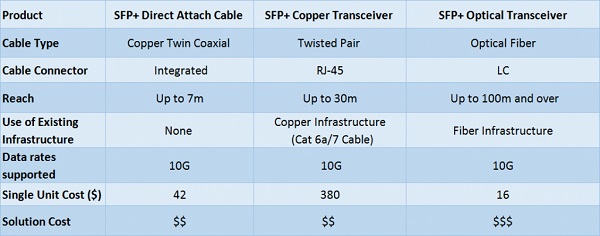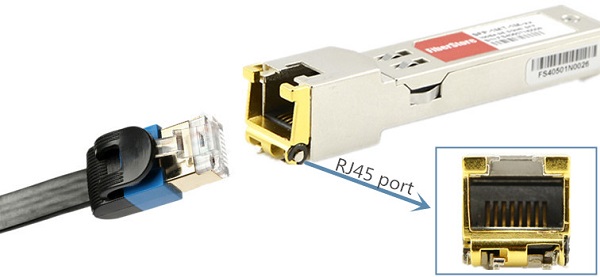10GBASE-T SFP+ Copper Transceiver: A New Option For 10GbE Network
by Keelian J. Fiber Optic Networking10GBASE-T SFP+ transceiver is specifically designed for high speed communication links that require 10 Gigabit Ethernet over copper cable (Cat 6a/7 cable). 10GBASE-T SFP+ copper transceiver is the first SFP+ transceiver that offers 10 Gb/s communication over this type of media. Compared with other 10GbE optical modules, the 10GBASE-T copper SFP+ transceiver has stable performance, you can take full advantage of the existing copper cabling. The following post will briefly introduce some related information about 10GBASE-T SFP+ transceiver.
10GBASE-T SFP+ copper transceiver has high performance, good reliability and is a cost-effective I/O solution for 10G Ethernet and 10G Fibre Channel applications. SFP+ 10GBASE-T copper transceiver is mainly used in Cat 6a or Cat 7 copper cabling system for 10G transmission with a maximum distance up to 100m. In addition, compared with SFP+ DAC, 10GBASE-T copper SFP+ transceiver can save at least 0.5W power consumption, and its port can both support STP (shielded twisted pair) and UTP (unshielded twisted pair). Therefore 10GBASE-T SFP+ transceiver is becoming more and more popular in network switches and servers because of its lower power consumption and pay-as-you-grow flexibility.
SFP+ DAC, SFP+ optical transceiver and 10GBASE-T SFP+ copper transceiver are three common components used in 10G connections. The following chart reveals the differences between them.

Form the figure, we can see that each option has its advantages, but 10GBASE-T’s compatibility with existing structured cabling devices and existing low-speed devices makes it uniquely suited for widespread deployment. These features, combined with superior cost and achievable features, make the simplest path of 10GBase migrate from Gigabit Ethernet to 10G Ethernet. What’s more, the 10GBASE-T SFP+ transceiver module has been optimized to save at least 0.5W per port compared to an embedded 10GBASE-T RJ45 port for link distances up to 30m. Thus, the power savings and corresponding operating cost reduction can be substantial.
- Cost effective at up to 30m distance on UTP cables
- Extension of the life of any switch hardware, without having to change existing infrastructure
- Architecture Flexibility: Supports Top of Rack, Middle of Row or End of Row architectures
- Auto-negotiable backward-compatibility with previous-generation BASE-T networks for a seamless migration to 10GbE
- Field twisted pair cabling with familiar RJ-45 connector
- Support for multi-gigabit data rates up to 10 Gbps

As 10GBASE-T network equipment becomes increasingly available, data center decision makers will want to take advantage of the cost savings, convenience, and flexibility provided by deploying 10 Gb/s technology over balanced twisted-pair copper cabling. Nowadays SFP+ 10GBASE-T transceiver, owing to the compatible issue with switches, is not offered by many vendors. However, from a network equipment designer’s perspective, 10G SFP+ copper modules will become popular in the near future. FS.COM has released 10GBASE-T SFP+ copper modules that are tested compatible with major brands like Cisco, Juniper, Dell, Brocade, Arista.
Sponsor Ads
Created on Nov 16th 2017 04:22. Viewed 440 times.



